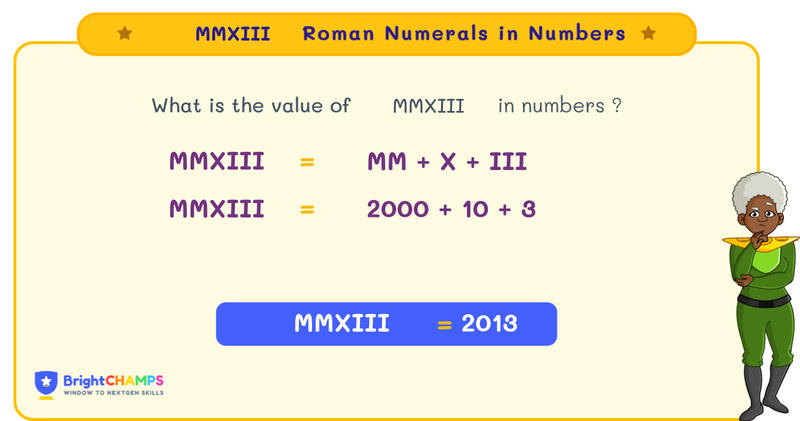Summarize this article:
 252 Learners
252 LearnersLast updated on August 5, 2025
MMXIII in Roman Numerals

To meet their daily commerce and administration needs, the ancient Romans developed Roman Numerals. This system used a combination of seven symbols — I, V, X, L, C, D, and M to represent numbers. Roman numerals were used to record transactions, keep track of data, and label military units. In this topic, we are going to learn about the Roman numeral MMXIII.

What is MMXIII in Roman Numerals?
The ancient Romans discovered that counting fingers could get very complicated after 10. To overcome this complexity, they developed the Roman numeric system, which became widely used throughout Europe as a standard writing system until the late Middle Ages. Seven symbols are used to represent numbers in the Roman numeral system — I, V, X, L, C, D, and M.
The numerals are made up of different combinations of these symbols. MMXIII in Roman numerals can be written in number form by adding the values of each Roman numeral, i.e., MMXIII = 2013.
Let us learn more about the Roman numeral MMXIII, how to write it, the mistakes we usually make, and ways to avoid these mistakes.


Basic Rules for MMXIII in Roman Numerals
When writing Roman numerals, there are a few rules that we need to follow based on the numerals we are trying to write. In this section, we will learn about the rules when writing Roman numerals and how to represent them.
Rule 1: Addition Method:
When a larger symbol is followed by a smaller symbol, we add the numerals. For example, in VIII, we have 5 + 3 = 8.
Rule 2: Repetition Method:
A symbol repeated three times in succession increases the value of the numeral. For example, XXX = 30.
Rule 3: Subtraction Method:
We use the subtraction method when a larger symbol follows a smaller symbol. For example, XL = 40 (which is 50 – 10).
Rule 4: Limitation Rule:
Symbols cannot be repeated more than three times, and some symbols, such as V, L, and D, cannot be repeated more than once. For example, 10 is represented as X and not VV.

How to Write MMXIII in Roman Numerals?
Let us learn about how to write MMXIII in Roman numerals. There are two methods that we can use to write Roman numerals:
- By Expansion Method
- By Grouping Method
Explore Our Programs



MMXIII in Roman Numerals by Expansion Method
The breaking down of Roman numerals into parts and then converting them into numerals is what we call the expansion method. The expansion method is the breaking down of Roman numerals into numerical form and adding them to get the final number.
Step 1: Break the Roman numerals into parts.
Step 2: Now write each of the Roman numerals with its numerical digit in the place value.
Step 3: Add the numerals together. For MMXIII,
Step 1: First, we break the Roman numerals. MMXIII = M + M + X + I + I + I
Step 2: Write the Roman Numerals for each part The Roman Numeral M is 1000 The Roman Numeral X is 10 The Roman Numeral I is 1
Step 3: Combine all the numbers M + M + X + I + I + I = 1000 + 1000 + 10 + 1 + 1 + 1 = 2013. Therefore, the Roman Numeral MMXIII is 2013.

MMXIII in Roman Numerals by Grouping Method
Using the subtraction and addition rules, we will apply the grouping method. This means we break the Roman numerals into smaller groups, which makes it easier to work with. This method groups the Roman numerals logically, and then we write the numbers for each group.
Step 1: Take the largest number and write the number for that Roman numeral.
Step 2: Write the Roman numeral using the subtraction and addition rules. Example: Let’s take the Roman numeral MMXIII.
Step 1: The larger Roman numerals are what we will begin with. Once split, the Roman numerals we get are MM and XIII. The numeral for MM is 2000.
Step 2: Now, we need to either add or subtract the smaller number, depending on its place. Here we add XIII to MM, and we will get MMXIII. The Roman numeral XIII is 13. Therefore, the numeral of MMXIII is 2013.

Common Mistakes and How to Avoid Them in MMXIII Roman Numerals
Students can make mistakes when studying Roman numerals. Here are a few common mistakes students make, and ways to avoid them.

MMXIII Roman Numerals Examples

Problem 1
A historian finds a document stating a total of MMXIII years since a city was founded. If the city was founded in DCCXLIV A.D., in what year was the document written? Write the answer in Roman numerals.

The document was written in the year MMDCCLVII.
Explanation
Convert the Roman numerals into decimal form: MMXIII = 2013
DCCXLIV = 744
Add the founding year to the duration: 744 + 2013 = 2757
Convert the sum into Roman numerals: 2757 = 2000 (MM) + 700 (DCC) + 50 (L) + 7 (VII) = MMDCCLVII

Problem 2
An ancient inscription describes a distance of MMXIII Roman miles. If a Roman mile is approximately 1.48 kilometers, how many kilometers is the distance? Provide the answer rounded to the nearest whole number.

The distance is approximately 2980 kilometers.
Explanation
Convert MMXIII into its decimal form: MMXIII = 2013
Multiply by the conversion factor (1.48 km/Roman mile): 2013 × 1.48 ≈ 2980 kilometers

Problem 3
An artifact is dated to be MMXIII years old in the year MMXX. How many years ago was the artifact created, in Roman numerals?

The artifact was created in the year VII B.C.
Explanation
Convert the current year MMXX and the age MMXIII into decimal form: MMXX = 2020
MMXIII = 2013 Subtract the artifact's age from the current year: 2020 - 2013 = 7
Since the result is less than the current era, it indicates a B.C. date: 7 = VII

Problem 4
A researcher divides the number MMXIII by the number XIII. What is the quotient in Roman numerals?

The quotient is CLV.
Explanation
Convert MMXIII and XIII into decimal form: MMXIII = 2013
XIII = 13
Divide the numbers: 2013 ÷ 13 = 155
Convert the result back to Roman numerals: 155 = 100 (C) + 50 (L) + 5 (V) = CLV

Problem 5
A manuscript mentions a sequence of MMXIII steps in a ritual, with each step taking approximately II minutes. How many hours does the entire ritual take? Provide the answer as a whole number.

The ritual takes approximately 67 hours.
Explanation
Convert MMXIII and II into decimal form: MMXIII = 2013
II = 2
Calculate the total time in minutes: 2013 × 2 = 4026 minutes
Convert minutes to hours (60 minutes per hour): 4026 ÷ 60 ≈ 67 hours


FAQs on MMXIII in Roman Numerals
1.What is XIII in Roman numerals?
2.Is MMXIII a prime number?
3.What is MMXIII + MMXIII?
4.What is MMMXIII?
5.Subtract XIII from MMXIII

Important Glossaries for MMXIII in Roman Numerals
- Addition Method: When a larger symbol is followed by a smaller symbol, the values are added together. For example, VI = 5 + 1 = 6.
- Subtraction Method: When a smaller symbol precedes a larger one, it is subtracted. For example, IV = 5 - 1 = 4.
- Prime Number: A number that has only two factors or multiples is called a prime number. For example, 23 is a prime number that has only two factors, 1 and itself.
- Repetition Rule: A symbol repeated up to three times increases the value of the numeral, like XXX = 30.
- Limitation Rule: Some symbols, such as V, L, and D, cannot be repeated. For example, 10 is represented as X and not VV.



Hiralee Lalitkumar Makwana
About the Author
Hiralee Lalitkumar Makwana has almost two years of teaching experience. She is a number ninja as she loves numbers. Her interest in numbers can be seen in the way she cracks math puzzles and hidden patterns.
Fun Fact
: She loves to read number jokes and games.

















